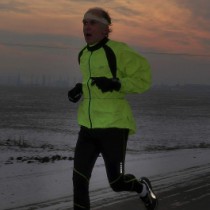UKÁZKA Z KNIHY: Devět zlatých pravidel veteránského sportování [článek]
behej.com 30.08.2015 21:37:11
Jak utéct času je název knižního titulu nakladatelství Mladá fronta,
který vyšel letos a jehož autorkou je Američanka s ukrajinskými kořeny Olga Kotelková.
Sportovkyně tělem i duší, neboť se na tartanu proháněla i po své
devadesátce. Přinášíme jejích devět pravidel, rad a doporučení pro
sportovce veterány. Další ukázku z této zdařilé knihy najdete
v nejnovějším čísle našeho časopisu.
Odkaz
na článek
rudo
 31.08.2015 00:38:49
31.08.2015 00:38:49
Exactly how exercise affects older people is complicated. On one level, exercise is a flat-out insult to the body. Downhill running tears quadriceps muscles as reliably as an injection of snake venom. All kinds of free radicals and other toxins are let loose. But the damage also triggers the production of antioxidants that boost the health of the body generally. So when you see a track athlete who looks as if that last 1,500-meter race damn near killed him, you’re right. It might have made him stronger in the deal.
rudo
 31.08.2015 00:41:27
31.08.2015 00:41:27
Exercise training helps stop muscle strength and endurance from slipping away. But it seems to also do something else, maintains Mark Tarnopolsky, a professor of pediatrics and medicine at McMaster University in Hamilton, Ontario (who also happens to be a top-ranked trail runner). Resistance exercise in particular seems to activate a muscle stem cell called a satellite cell. With the infusion of these squeaky-clean cells into the system, the mitochondria seem to rejuvenate. (The phenomenon has been called “gene shifting.”) If Tarnopolsky is right, exercise in older adults can roll back the odometer. After six months of twice weekly strength exercise training, he has shown, the biochemical, physiological and genetic signature of older muscle is “turned back” nearly 15 or 20 years.
2 x za tyzden silovy trenink
rudo
 31.08.2015 00:44:19
31.08.2015 00:44:19
The conundrum for masters athletes — though it seems Kotelko’s great fortune to have largely escaped the phenomenon — is this: Big physiological benefits from exercise are there for the taking. You just have to keep exercising. But you can’t exercise if the body breaks down. To avoid injuries, aging track athletes are often advised to keep to their old routines but to lower the intensity. The best advertisement for that strategy was a race turned in five years ago by a 73-year-old from Ontario. Age-graded, Ed Whitlock’s 2:54 marathon (the equivalent of a 20-year-old running 2:03.57) was the fastest ever run. When people collared him afterward to find out his training secret, they learned that he ran every day, slowly, for hours, around the local cemetery.
niekolkohodinovy velmi pomaly beh, kazdodenne, okolo cintorina
rudo
 31.08.2015 02:33:43
31.08.2015 02:33:43
high jump
The flop allows you to jump higher than other methods do because your center of gravity never actually clears the bar. But the severe back arch demands a suppleness that’s alien to the aging body, which is why pretty much no one over 65 does it. Kotelko was already too old to flop when she took up track at age 77. Instead, she sort of bestrides the bar. Her world record of 2.7 feet is just a little higher than the superfoamy mat. Overall, Kotelko’s high jump gives the impression of someone taking a run at a hotel-room bed.
jej skok do vysky vyzera ako ked sa niekto rozbehne v hotelovej izbe a skoci do postele
rudo
 31.08.2015 02:44:55
31.08.2015 02:44:55
http://www.nytimes.com/…letes-t.html?_r=0
text v prispevkoch je z toho clanku, ktory je linknuty cez wiki, ktora bola linknuta v clanku na fore
jm1
 07.09.2015 23:17:47
07.09.2015 23:17:47
>> rudo, 31. 08. 2015 00:44:19 …niekolkohodinovy velmi pomaly beh, kazdodenne, okolo cintorina…
V knize je (na str. 76 dole) napsan vice mene OPAK ![]() : „…Jde o intenzitu.
O jakou intenzitu? Nejmene na 80% Vaseho maxima … Atleticke discipliny, jimz
se Olga venuje, namahaji jeji telo presne spravnym zpusobem: kladou na ni vysoke
naroky po kratky cas“
: „…Jde o intenzitu.
O jakou intenzitu? Nejmene na 80% Vaseho maxima … Atleticke discipliny, jimz
se Olga venuje, namahaji jeji telo presne spravnym zpusobem: kladou na ni vysoke
naroky po kratky cas“
rudo
 08.09.2015 00:53:35
08.09.2015 00:53:35
>> jm1, 07. 09. 2015 23:17:47
Age-graded, Ed Whitlock’s 2:54 marathon (the equivalent of a 20-year-old running 2:03.57) was the fastest ever run. When people collared him afterward to find out his training secret, they learned that he ran every day, slowly, for hours, around the local cemetery.
ako by si to velmi strucne prelozil 1 vetou ?
Hodnocení příspěvků
Pro hodnocení příspěvků se nejprve musíte přihlásit.
Pokud ještě registraci nemáte, můžete se zaregistrovat zde.
Pro přidání komentáře se musíte přihlásit nebo registrovat, pokud ještě registraci nemáte.





